HI5020 Corporate Accounting: A Financial Analysis of Iress Limited
VerifiedAdded on 2024/04/26
|14
|2363
|230
Report
AI Summary
This report provides a comprehensive analysis of Iress Limited's corporate accounting practices, focusing on equity components and tax-related items as presented in its 2016 annual report. It examines various elements of equity, including issued capital, reserves, and retained earnings, detailing changes and their underlying reasons. The report also delves into the company's income tax expenses, deferred tax assets and liabilities, and the discrepancies between accounting income and taxable income. It investigates the differences between income tax expenses reported in the income statement and the income tax paid as shown in the cash flow statement. The analysis considers the application of Australian taxation rules and highlights interesting, confusing, and difficult aspects of Iress Limited's tax treatment, offering new insights into corporate income tax accounting. This document is available on Desklib, a platform offering a wide range of study resources including past papers and solved assignments.
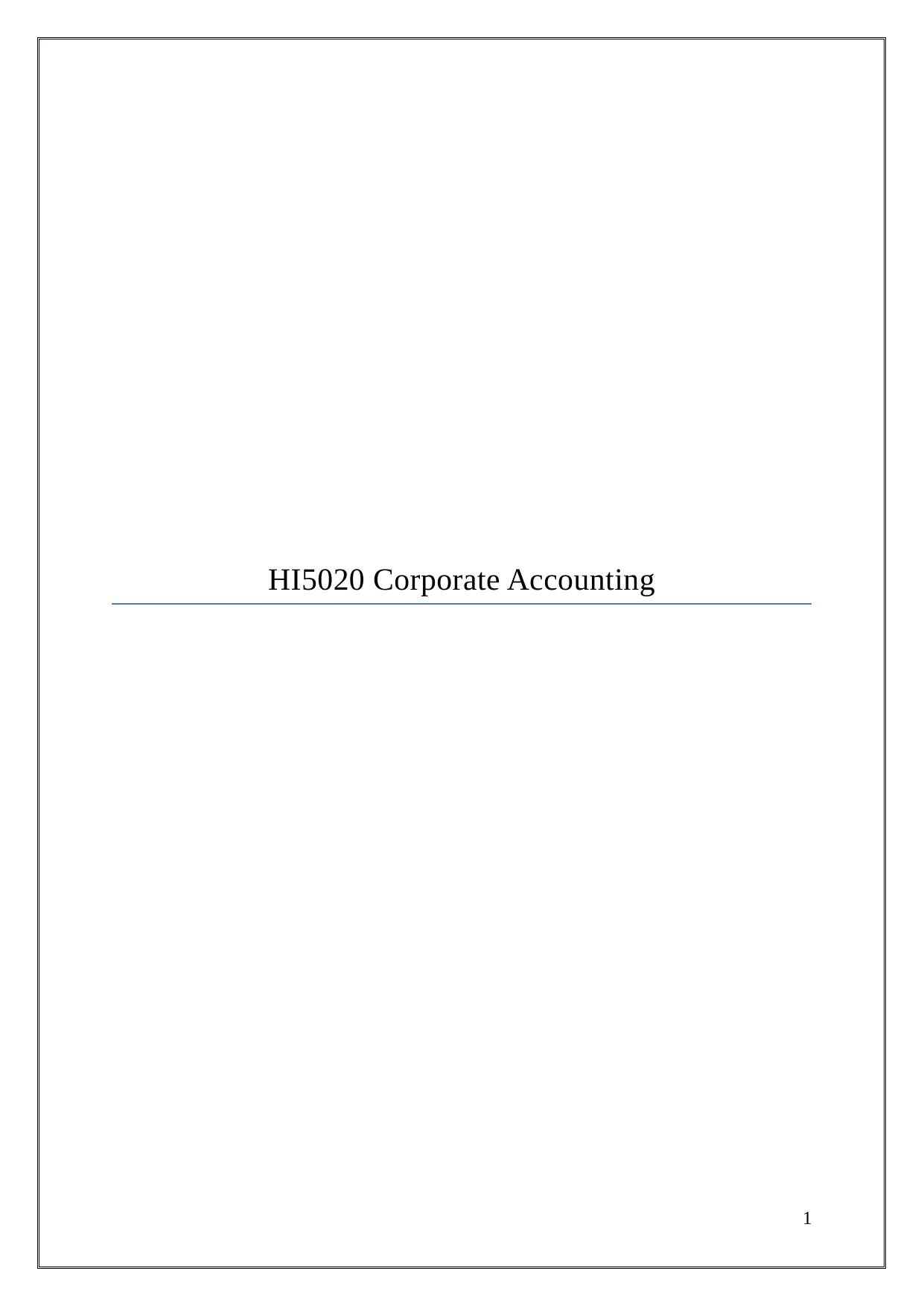
HI5020 Corporate Accounting
1
1
Paraphrase This Document
Need a fresh take? Get an instant paraphrase of this document with our AI Paraphraser
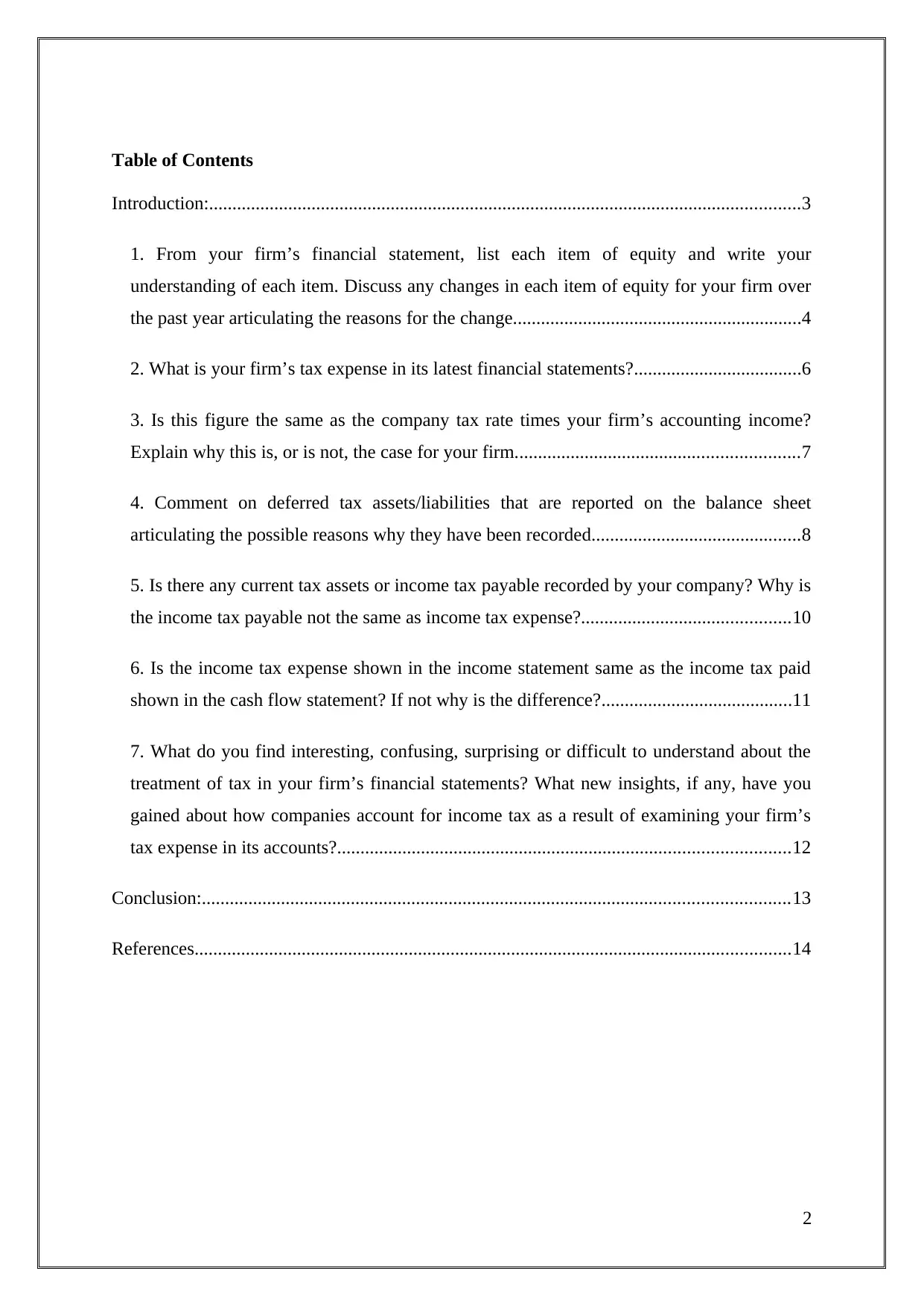
Table of Contents
Introduction:...............................................................................................................................3
1. From your firm’s financial statement, list each item of equity and write your
understanding of each item. Discuss any changes in each item of equity for your firm over
the past year articulating the reasons for the change..............................................................4
2. What is your firm’s tax expense in its latest financial statements?....................................6
3. Is this figure the same as the company tax rate times your firm’s accounting income?
Explain why this is, or is not, the case for your firm.............................................................7
4. Comment on deferred tax assets/liabilities that are reported on the balance sheet
articulating the possible reasons why they have been recorded.............................................8
5. Is there any current tax assets or income tax payable recorded by your company? Why is
the income tax payable not the same as income tax expense?.............................................10
6. Is the income tax expense shown in the income statement same as the income tax paid
shown in the cash flow statement? If not why is the difference?.........................................11
7. What do you find interesting, confusing, surprising or difficult to understand about the
treatment of tax in your firm’s financial statements? What new insights, if any, have you
gained about how companies account for income tax as a result of examining your firm’s
tax expense in its accounts?.................................................................................................12
Conclusion:..............................................................................................................................13
References................................................................................................................................14
2
Introduction:...............................................................................................................................3
1. From your firm’s financial statement, list each item of equity and write your
understanding of each item. Discuss any changes in each item of equity for your firm over
the past year articulating the reasons for the change..............................................................4
2. What is your firm’s tax expense in its latest financial statements?....................................6
3. Is this figure the same as the company tax rate times your firm’s accounting income?
Explain why this is, or is not, the case for your firm.............................................................7
4. Comment on deferred tax assets/liabilities that are reported on the balance sheet
articulating the possible reasons why they have been recorded.............................................8
5. Is there any current tax assets or income tax payable recorded by your company? Why is
the income tax payable not the same as income tax expense?.............................................10
6. Is the income tax expense shown in the income statement same as the income tax paid
shown in the cash flow statement? If not why is the difference?.........................................11
7. What do you find interesting, confusing, surprising or difficult to understand about the
treatment of tax in your firm’s financial statements? What new insights, if any, have you
gained about how companies account for income tax as a result of examining your firm’s
tax expense in its accounts?.................................................................................................12
Conclusion:..............................................................................................................................13
References................................................................................................................................14
2
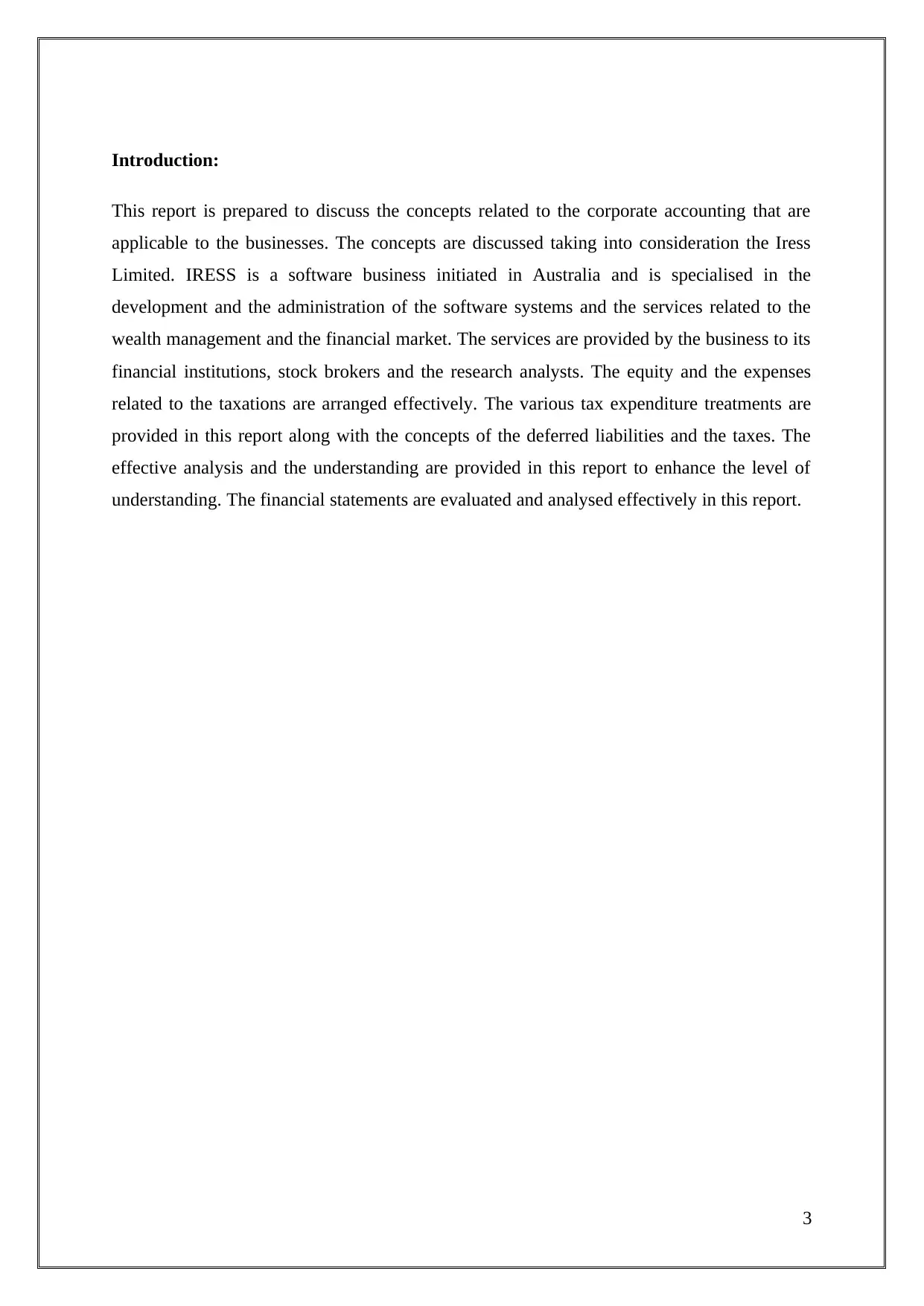
Introduction:
This report is prepared to discuss the concepts related to the corporate accounting that are
applicable to the businesses. The concepts are discussed taking into consideration the Iress
Limited. IRESS is a software business initiated in Australia and is specialised in the
development and the administration of the software systems and the services related to the
wealth management and the financial market. The services are provided by the business to its
financial institutions, stock brokers and the research analysts. The equity and the expenses
related to the taxations are arranged effectively. The various tax expenditure treatments are
provided in this report along with the concepts of the deferred liabilities and the taxes. The
effective analysis and the understanding are provided in this report to enhance the level of
understanding. The financial statements are evaluated and analysed effectively in this report.
3
This report is prepared to discuss the concepts related to the corporate accounting that are
applicable to the businesses. The concepts are discussed taking into consideration the Iress
Limited. IRESS is a software business initiated in Australia and is specialised in the
development and the administration of the software systems and the services related to the
wealth management and the financial market. The services are provided by the business to its
financial institutions, stock brokers and the research analysts. The equity and the expenses
related to the taxations are arranged effectively. The various tax expenditure treatments are
provided in this report along with the concepts of the deferred liabilities and the taxes. The
effective analysis and the understanding are provided in this report to enhance the level of
understanding. The financial statements are evaluated and analysed effectively in this report.
3
⊘ This is a preview!⊘
Do you want full access?
Subscribe today to unlock all pages.

Trusted by 1+ million students worldwide
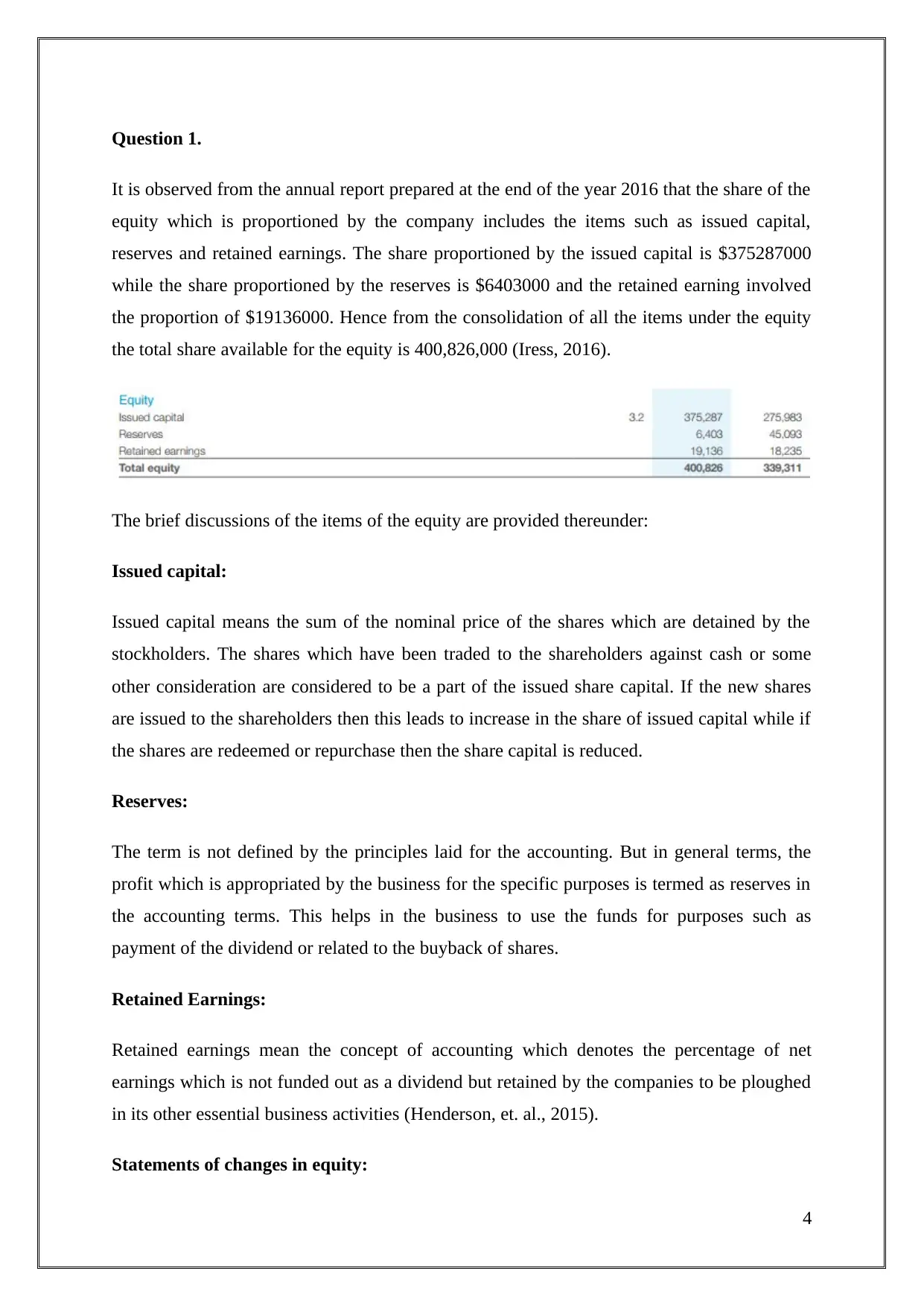
Question 1.
It is observed from the annual report prepared at the end of the year 2016 that the share of the
equity which is proportioned by the company includes the items such as issued capital,
reserves and retained earnings. The share proportioned by the issued capital is $375287000
while the share proportioned by the reserves is $6403000 and the retained earning involved
the proportion of $19136000. Hence from the consolidation of all the items under the equity
the total share available for the equity is 400,826,000 (Iress, 2016).
The brief discussions of the items of the equity are provided thereunder:
Issued capital:
Issued capital means the sum of the nominal price of the shares which are detained by the
stockholders. The shares which have been traded to the shareholders against cash or some
other consideration are considered to be a part of the issued share capital. If the new shares
are issued to the shareholders then this leads to increase in the share of issued capital while if
the shares are redeemed or repurchase then the share capital is reduced.
Reserves:
The term is not defined by the principles laid for the accounting. But in general terms, the
profit which is appropriated by the business for the specific purposes is termed as reserves in
the accounting terms. This helps in the business to use the funds for purposes such as
payment of the dividend or related to the buyback of shares.
Retained Earnings:
Retained earnings mean the concept of accounting which denotes the percentage of net
earnings which is not funded out as a dividend but retained by the companies to be ploughed
in its other essential business activities (Henderson, et. al., 2015).
Statements of changes in equity:
4
It is observed from the annual report prepared at the end of the year 2016 that the share of the
equity which is proportioned by the company includes the items such as issued capital,
reserves and retained earnings. The share proportioned by the issued capital is $375287000
while the share proportioned by the reserves is $6403000 and the retained earning involved
the proportion of $19136000. Hence from the consolidation of all the items under the equity
the total share available for the equity is 400,826,000 (Iress, 2016).
The brief discussions of the items of the equity are provided thereunder:
Issued capital:
Issued capital means the sum of the nominal price of the shares which are detained by the
stockholders. The shares which have been traded to the shareholders against cash or some
other consideration are considered to be a part of the issued share capital. If the new shares
are issued to the shareholders then this leads to increase in the share of issued capital while if
the shares are redeemed or repurchase then the share capital is reduced.
Reserves:
The term is not defined by the principles laid for the accounting. But in general terms, the
profit which is appropriated by the business for the specific purposes is termed as reserves in
the accounting terms. This helps in the business to use the funds for purposes such as
payment of the dividend or related to the buyback of shares.
Retained Earnings:
Retained earnings mean the concept of accounting which denotes the percentage of net
earnings which is not funded out as a dividend but retained by the companies to be ploughed
in its other essential business activities (Henderson, et. al., 2015).
Statements of changes in equity:
4
Paraphrase This Document
Need a fresh take? Get an instant paraphrase of this document with our AI Paraphraser
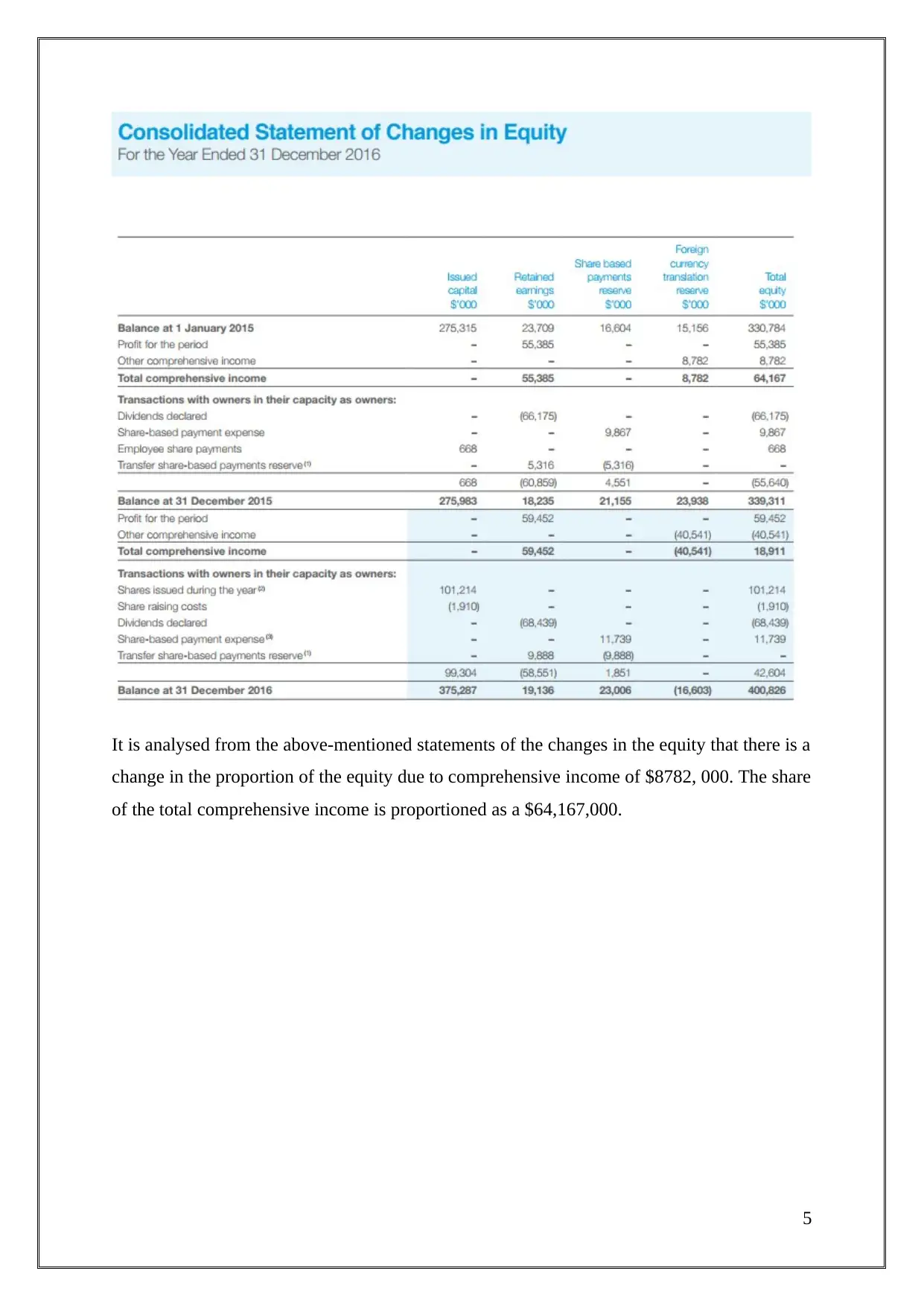
It is analysed from the above-mentioned statements of the changes in the equity that there is a
change in the proportion of the equity due to comprehensive income of $8782, 000. The share
of the total comprehensive income is proportioned as a $64,167,000.
5
change in the proportion of the equity due to comprehensive income of $8782, 000. The share
of the total comprehensive income is proportioned as a $64,167,000.
5
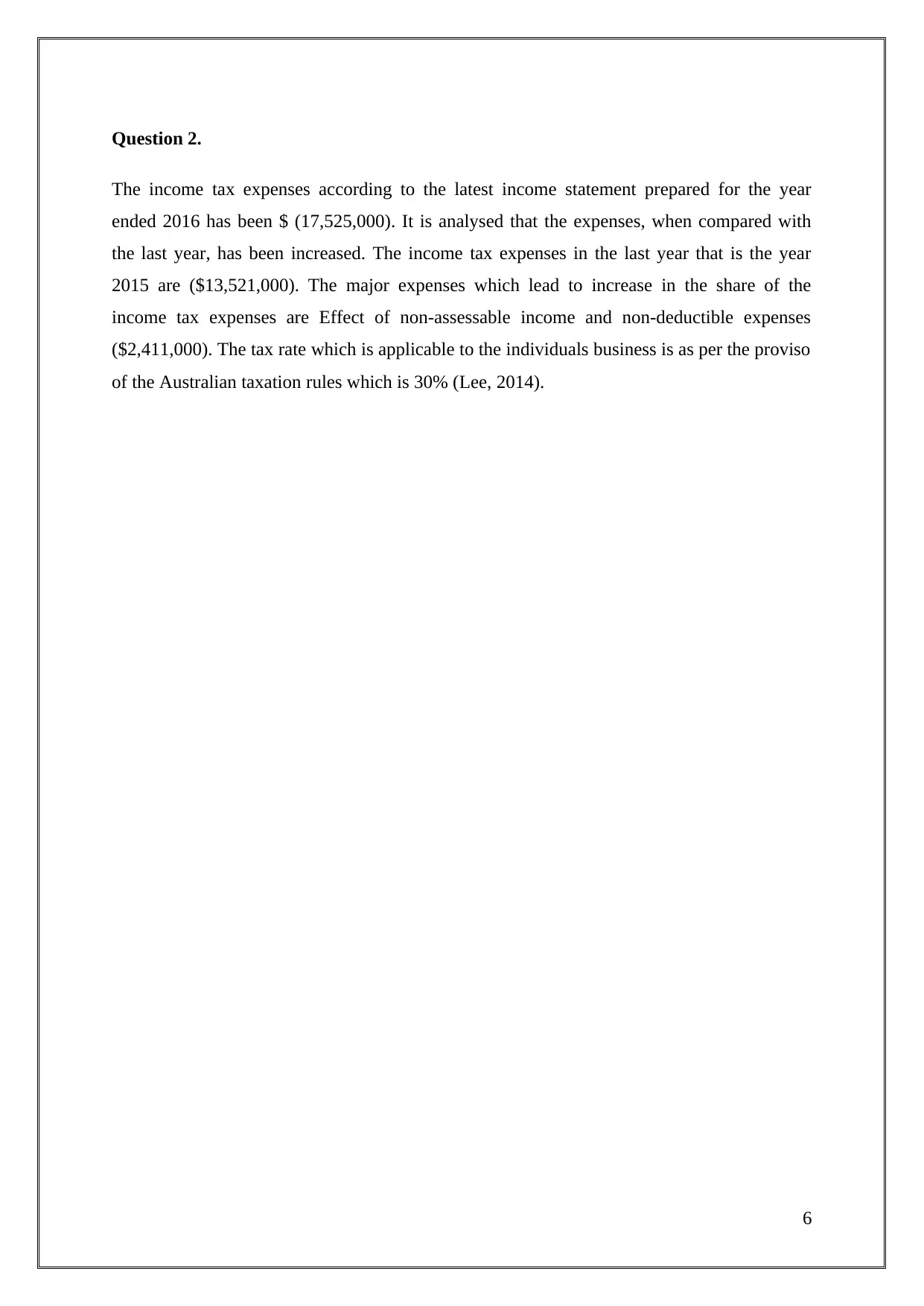
Question 2.
The income tax expenses according to the latest income statement prepared for the year
ended 2016 has been $ (17,525,000). It is analysed that the expenses, when compared with
the last year, has been increased. The income tax expenses in the last year that is the year
2015 are ($13,521,000). The major expenses which lead to increase in the share of the
income tax expenses are Effect of non-assessable income and non-deductible expenses
($2,411,000). The tax rate which is applicable to the individuals business is as per the proviso
of the Australian taxation rules which is 30% (Lee, 2014).
6
The income tax expenses according to the latest income statement prepared for the year
ended 2016 has been $ (17,525,000). It is analysed that the expenses, when compared with
the last year, has been increased. The income tax expenses in the last year that is the year
2015 are ($13,521,000). The major expenses which lead to increase in the share of the
income tax expenses are Effect of non-assessable income and non-deductible expenses
($2,411,000). The tax rate which is applicable to the individuals business is as per the proviso
of the Australian taxation rules which is 30% (Lee, 2014).
6
⊘ This is a preview!⊘
Do you want full access?
Subscribe today to unlock all pages.

Trusted by 1+ million students worldwide
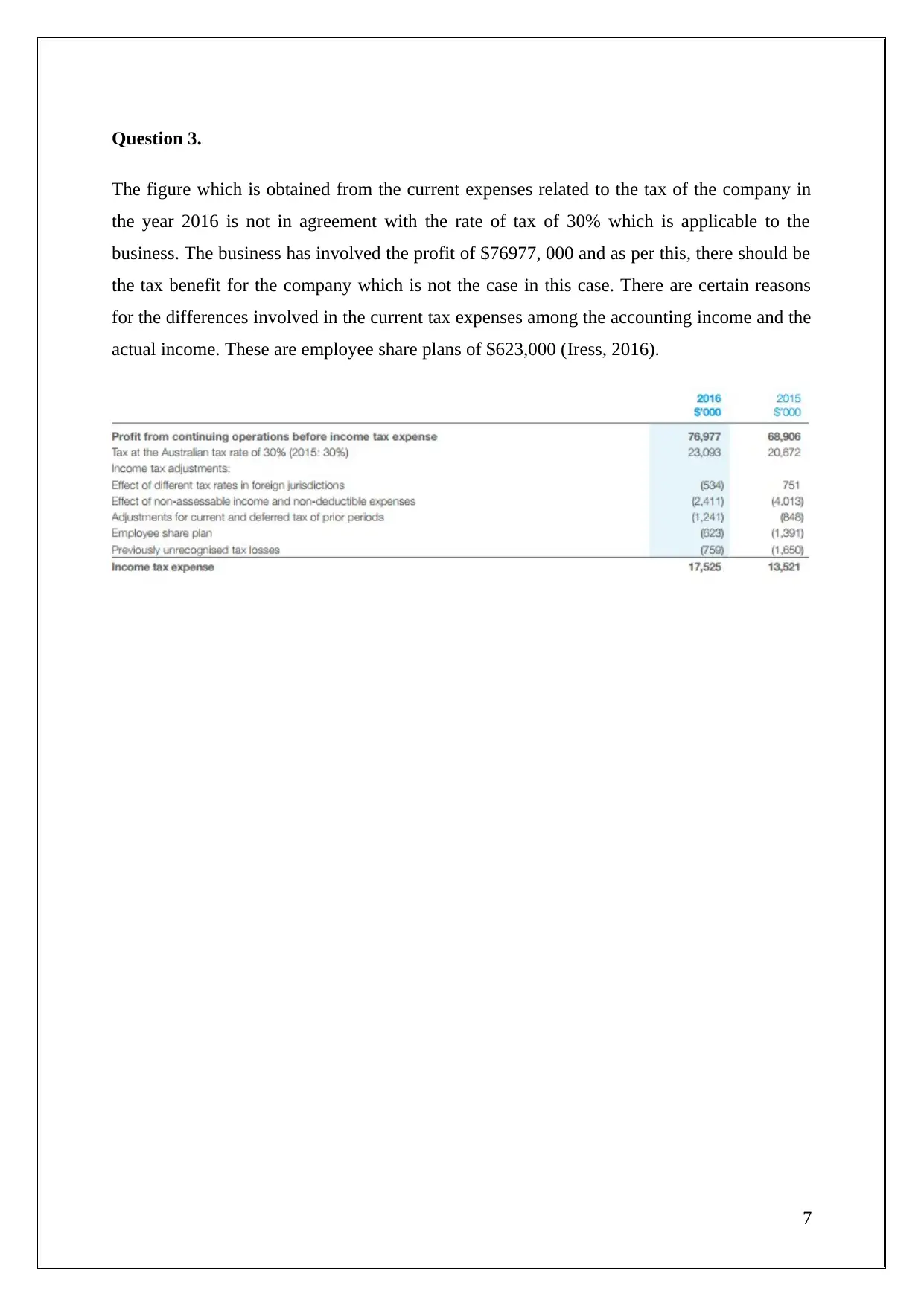
Question 3.
The figure which is obtained from the current expenses related to the tax of the company in
the year 2016 is not in agreement with the rate of tax of 30% which is applicable to the
business. The business has involved the profit of $76977, 000 and as per this, there should be
the tax benefit for the company which is not the case in this case. There are certain reasons
for the differences involved in the current tax expenses among the accounting income and the
actual income. These are employee share plans of $623,000 (Iress, 2016).
7
The figure which is obtained from the current expenses related to the tax of the company in
the year 2016 is not in agreement with the rate of tax of 30% which is applicable to the
business. The business has involved the profit of $76977, 000 and as per this, there should be
the tax benefit for the company which is not the case in this case. There are certain reasons
for the differences involved in the current tax expenses among the accounting income and the
actual income. These are employee share plans of $623,000 (Iress, 2016).
7
Paraphrase This Document
Need a fresh take? Get an instant paraphrase of this document with our AI Paraphraser
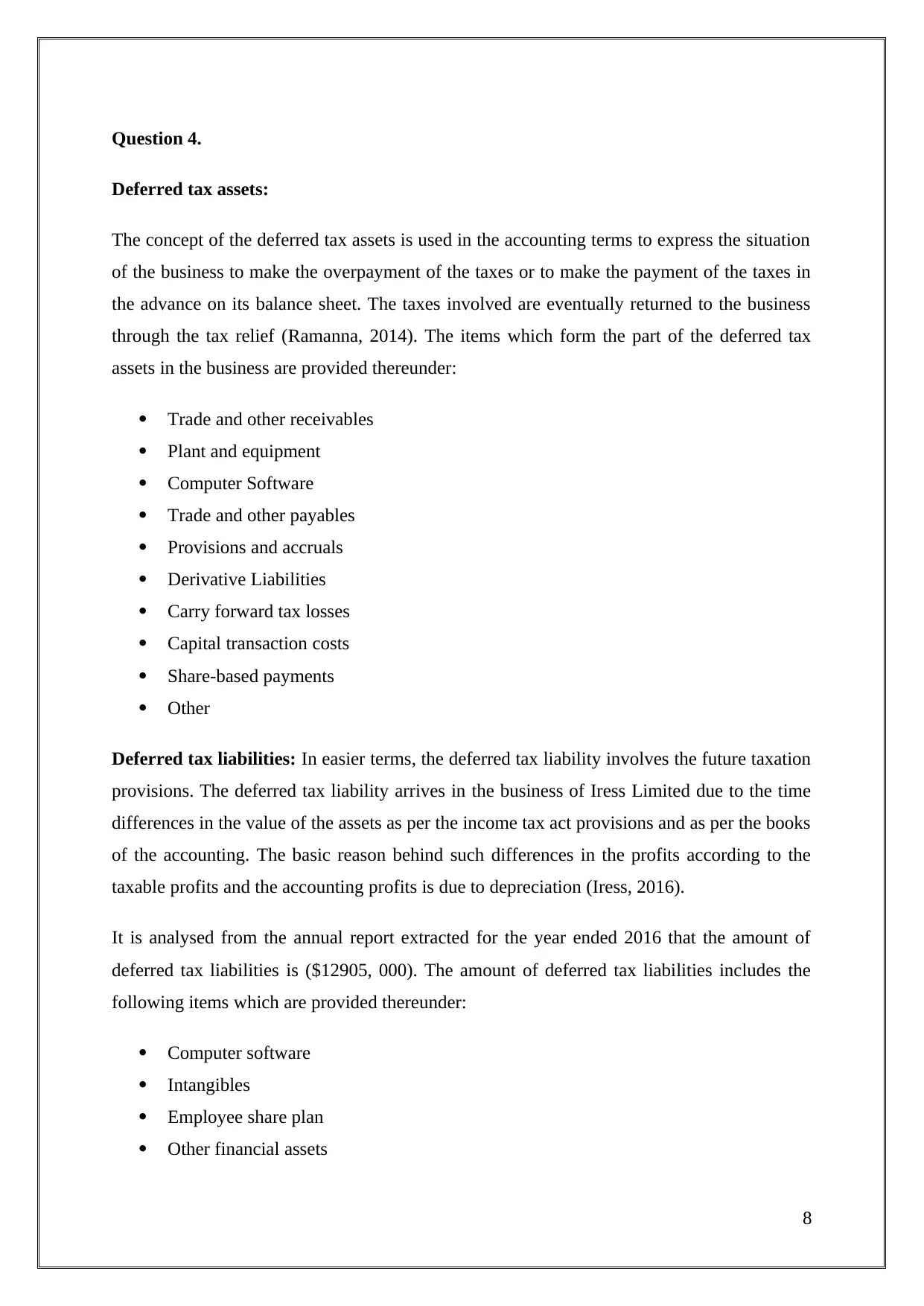
Question 4.
Deferred tax assets:
The concept of the deferred tax assets is used in the accounting terms to express the situation
of the business to make the overpayment of the taxes or to make the payment of the taxes in
the advance on its balance sheet. The taxes involved are eventually returned to the business
through the tax relief (Ramanna, 2014). The items which form the part of the deferred tax
assets in the business are provided thereunder:
Trade and other receivables
Plant and equipment
Computer Software
Trade and other payables
Provisions and accruals
Derivative Liabilities
Carry forward tax losses
Capital transaction costs
Share-based payments
Other
Deferred tax liabilities: In easier terms, the deferred tax liability involves the future taxation
provisions. The deferred tax liability arrives in the business of Iress Limited due to the time
differences in the value of the assets as per the income tax act provisions and as per the books
of the accounting. The basic reason behind such differences in the profits according to the
taxable profits and the accounting profits is due to depreciation (Iress, 2016).
It is analysed from the annual report extracted for the year ended 2016 that the amount of
deferred tax liabilities is ($12905, 000). The amount of deferred tax liabilities includes the
following items which are provided thereunder:
Computer software
Intangibles
Employee share plan
Other financial assets
8
Deferred tax assets:
The concept of the deferred tax assets is used in the accounting terms to express the situation
of the business to make the overpayment of the taxes or to make the payment of the taxes in
the advance on its balance sheet. The taxes involved are eventually returned to the business
through the tax relief (Ramanna, 2014). The items which form the part of the deferred tax
assets in the business are provided thereunder:
Trade and other receivables
Plant and equipment
Computer Software
Trade and other payables
Provisions and accruals
Derivative Liabilities
Carry forward tax losses
Capital transaction costs
Share-based payments
Other
Deferred tax liabilities: In easier terms, the deferred tax liability involves the future taxation
provisions. The deferred tax liability arrives in the business of Iress Limited due to the time
differences in the value of the assets as per the income tax act provisions and as per the books
of the accounting. The basic reason behind such differences in the profits according to the
taxable profits and the accounting profits is due to depreciation (Iress, 2016).
It is analysed from the annual report extracted for the year ended 2016 that the amount of
deferred tax liabilities is ($12905, 000). The amount of deferred tax liabilities includes the
following items which are provided thereunder:
Computer software
Intangibles
Employee share plan
Other financial assets
8
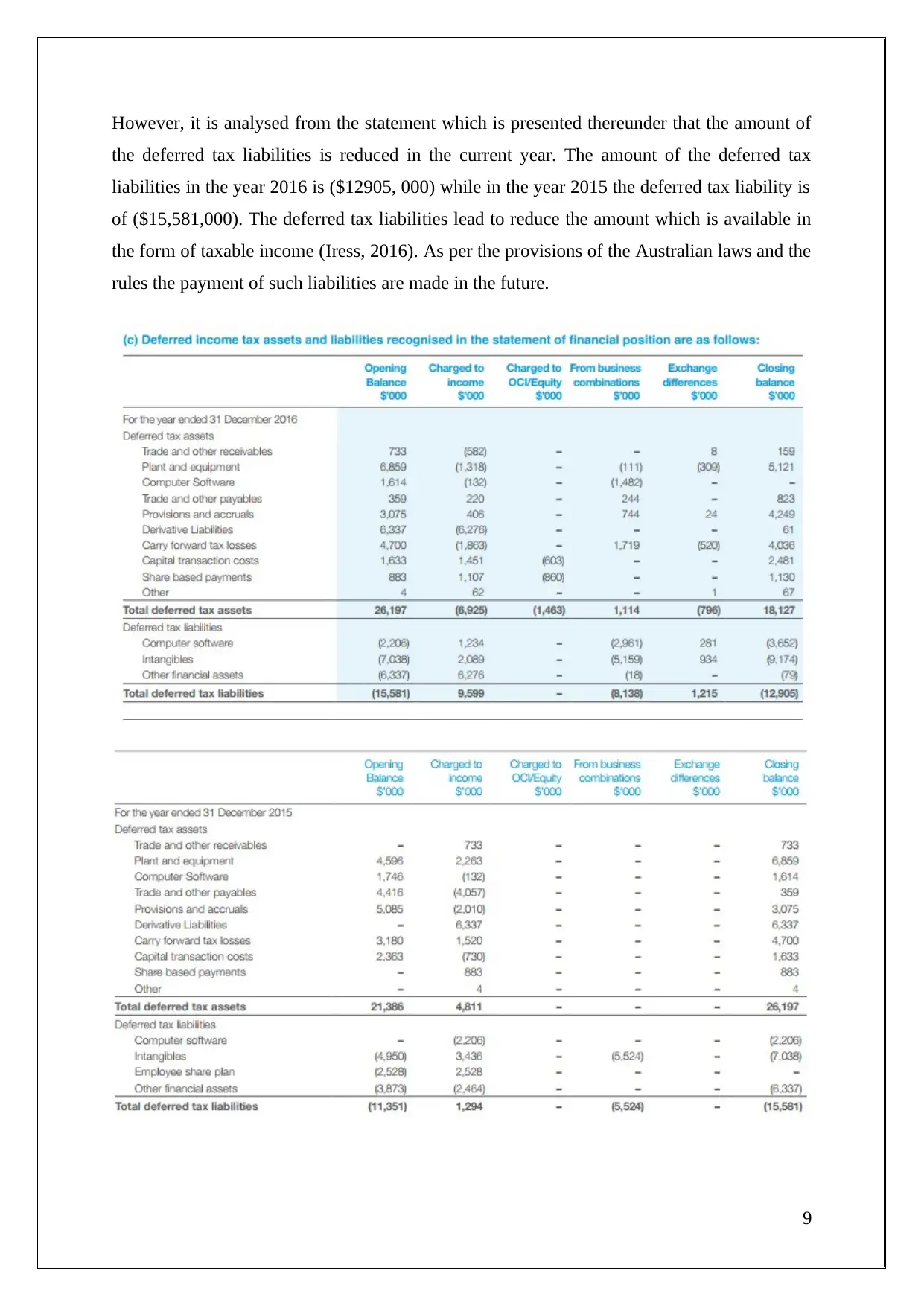
However, it is analysed from the statement which is presented thereunder that the amount of
the deferred tax liabilities is reduced in the current year. The amount of the deferred tax
liabilities in the year 2016 is ($12905, 000) while in the year 2015 the deferred tax liability is
of ($15,581,000). The deferred tax liabilities lead to reduce the amount which is available in
the form of taxable income (Iress, 2016). As per the provisions of the Australian laws and the
rules the payment of such liabilities are made in the future.
9
the deferred tax liabilities is reduced in the current year. The amount of the deferred tax
liabilities in the year 2016 is ($12905, 000) while in the year 2015 the deferred tax liability is
of ($15,581,000). The deferred tax liabilities lead to reduce the amount which is available in
the form of taxable income (Iress, 2016). As per the provisions of the Australian laws and the
rules the payment of such liabilities are made in the future.
9
⊘ This is a preview!⊘
Do you want full access?
Subscribe today to unlock all pages.

Trusted by 1+ million students worldwide
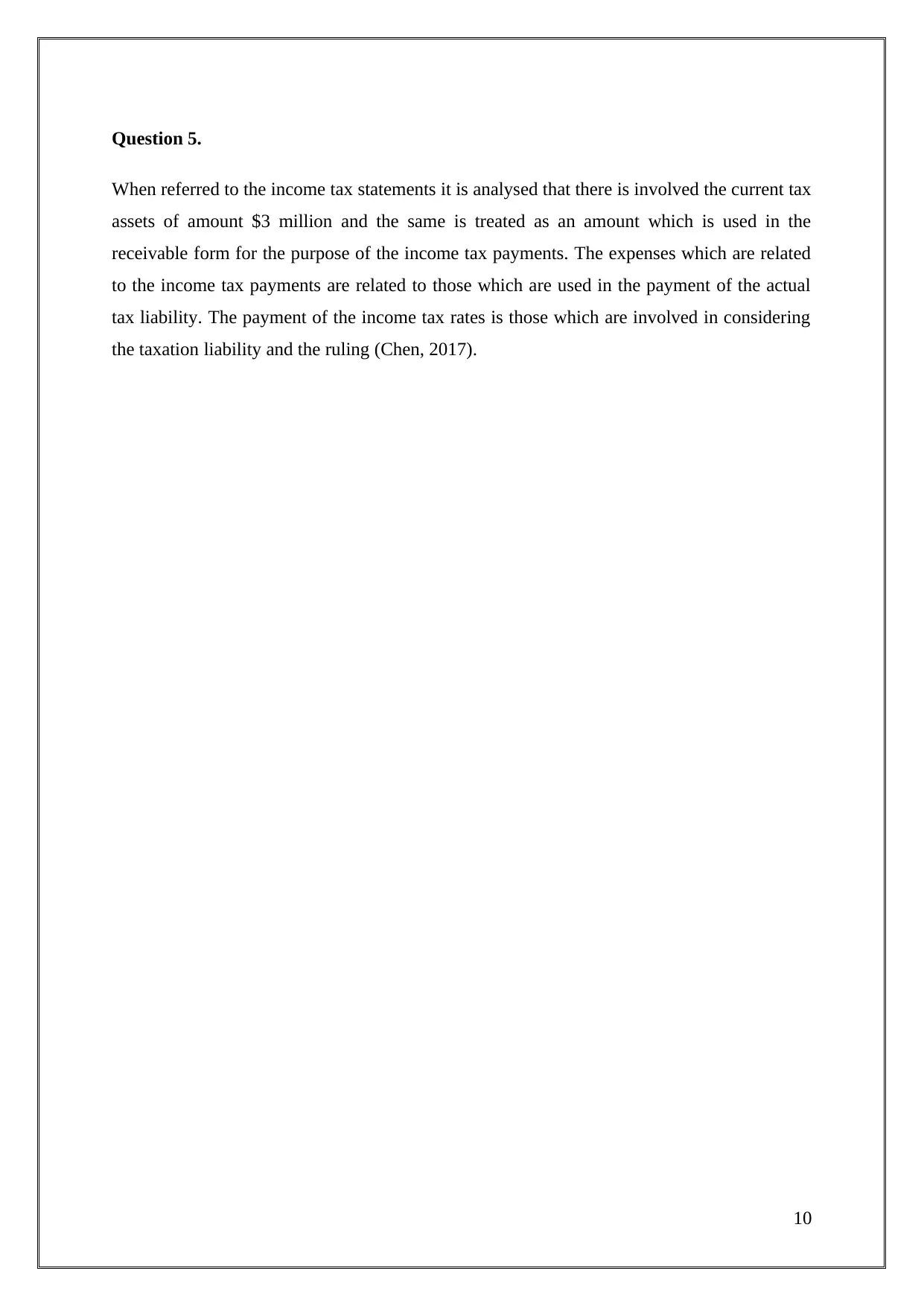
Question 5.
When referred to the income tax statements it is analysed that there is involved the current tax
assets of amount $3 million and the same is treated as an amount which is used in the
receivable form for the purpose of the income tax payments. The expenses which are related
to the income tax payments are related to those which are used in the payment of the actual
tax liability. The payment of the income tax rates is those which are involved in considering
the taxation liability and the ruling (Chen, 2017).
10
When referred to the income tax statements it is analysed that there is involved the current tax
assets of amount $3 million and the same is treated as an amount which is used in the
receivable form for the purpose of the income tax payments. The expenses which are related
to the income tax payments are related to those which are used in the payment of the actual
tax liability. The payment of the income tax rates is those which are involved in considering
the taxation liability and the ruling (Chen, 2017).
10
Paraphrase This Document
Need a fresh take? Get an instant paraphrase of this document with our AI Paraphraser
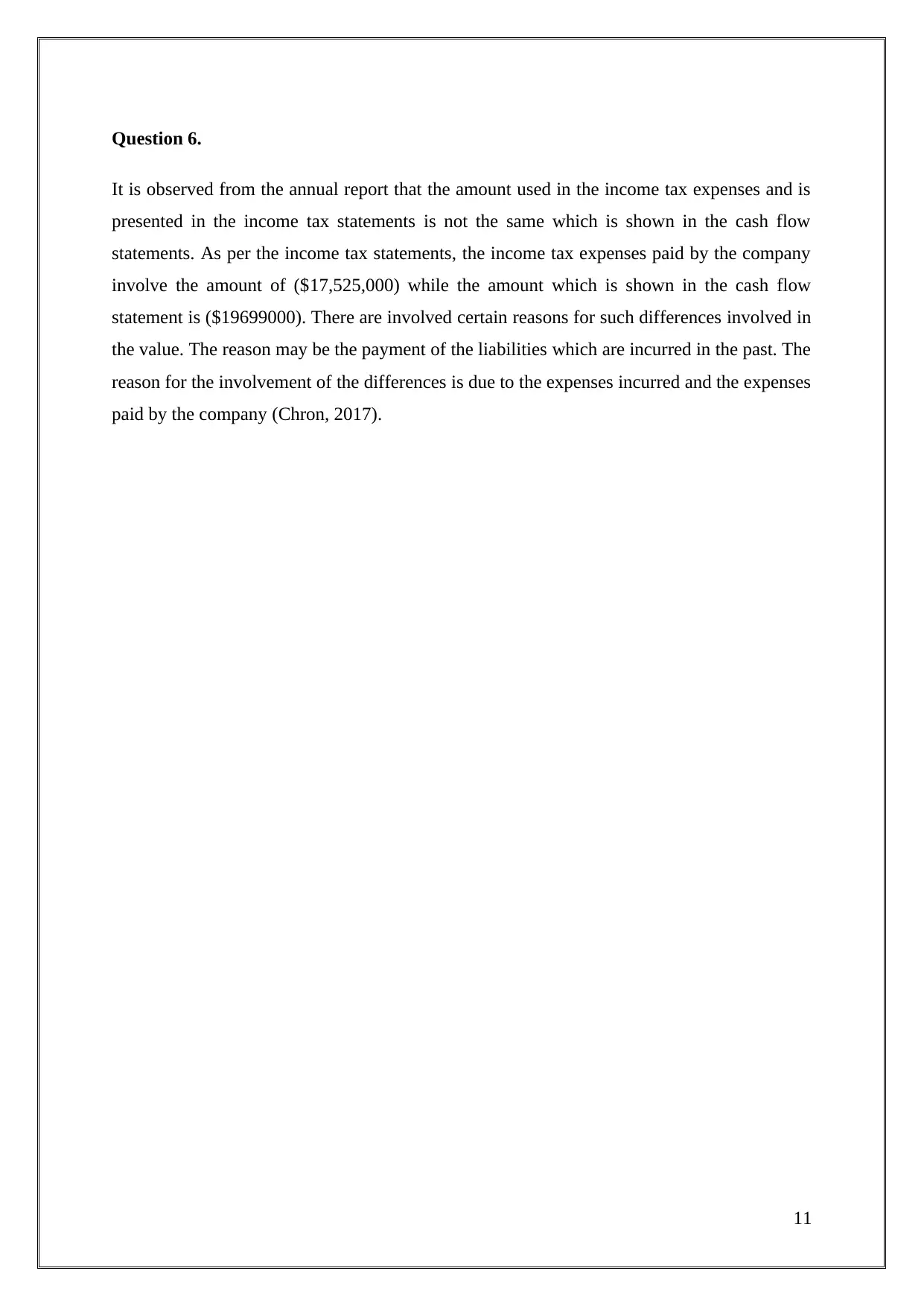
Question 6.
It is observed from the annual report that the amount used in the income tax expenses and is
presented in the income tax statements is not the same which is shown in the cash flow
statements. As per the income tax statements, the income tax expenses paid by the company
involve the amount of ($17,525,000) while the amount which is shown in the cash flow
statement is ($19699000). There are involved certain reasons for such differences involved in
the value. The reason may be the payment of the liabilities which are incurred in the past. The
reason for the involvement of the differences is due to the expenses incurred and the expenses
paid by the company (Chron, 2017).
11
It is observed from the annual report that the amount used in the income tax expenses and is
presented in the income tax statements is not the same which is shown in the cash flow
statements. As per the income tax statements, the income tax expenses paid by the company
involve the amount of ($17,525,000) while the amount which is shown in the cash flow
statement is ($19699000). There are involved certain reasons for such differences involved in
the value. The reason may be the payment of the liabilities which are incurred in the past. The
reason for the involvement of the differences is due to the expenses incurred and the expenses
paid by the company (Chron, 2017).
11
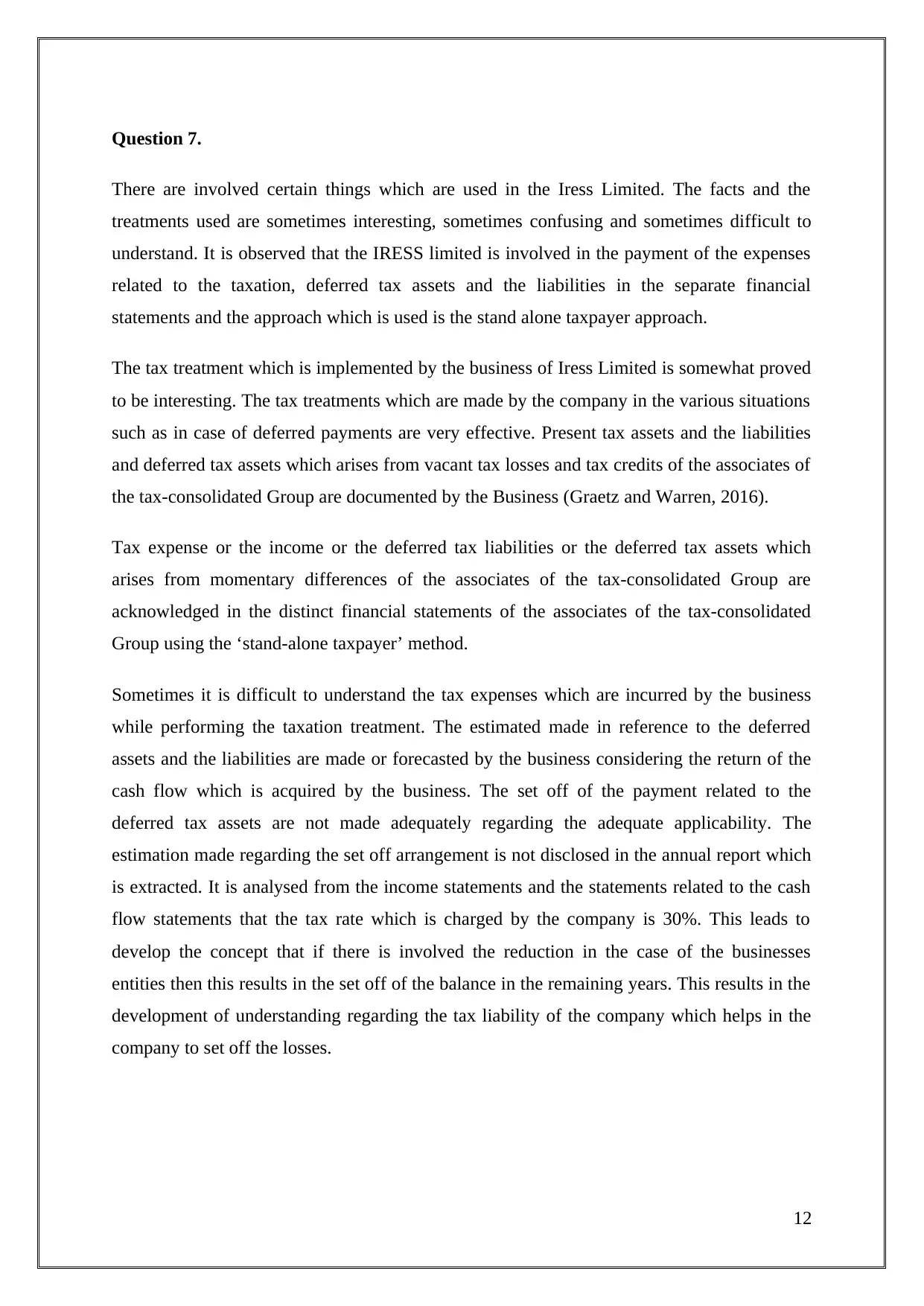
Question 7.
There are involved certain things which are used in the Iress Limited. The facts and the
treatments used are sometimes interesting, sometimes confusing and sometimes difficult to
understand. It is observed that the IRESS limited is involved in the payment of the expenses
related to the taxation, deferred tax assets and the liabilities in the separate financial
statements and the approach which is used is the stand alone taxpayer approach.
The tax treatment which is implemented by the business of Iress Limited is somewhat proved
to be interesting. The tax treatments which are made by the company in the various situations
such as in case of deferred payments are very effective. Present tax assets and the liabilities
and deferred tax assets which arises from vacant tax losses and tax credits of the associates of
the tax-consolidated Group are documented by the Business (Graetz and Warren, 2016).
Tax expense or the income or the deferred tax liabilities or the deferred tax assets which
arises from momentary differences of the associates of the tax-consolidated Group are
acknowledged in the distinct financial statements of the associates of the tax-consolidated
Group using the ‘stand-alone taxpayer’ method.
Sometimes it is difficult to understand the tax expenses which are incurred by the business
while performing the taxation treatment. The estimated made in reference to the deferred
assets and the liabilities are made or forecasted by the business considering the return of the
cash flow which is acquired by the business. The set off of the payment related to the
deferred tax assets are not made adequately regarding the adequate applicability. The
estimation made regarding the set off arrangement is not disclosed in the annual report which
is extracted. It is analysed from the income statements and the statements related to the cash
flow statements that the tax rate which is charged by the company is 30%. This leads to
develop the concept that if there is involved the reduction in the case of the businesses
entities then this results in the set off of the balance in the remaining years. This results in the
development of understanding regarding the tax liability of the company which helps in the
company to set off the losses.
12
There are involved certain things which are used in the Iress Limited. The facts and the
treatments used are sometimes interesting, sometimes confusing and sometimes difficult to
understand. It is observed that the IRESS limited is involved in the payment of the expenses
related to the taxation, deferred tax assets and the liabilities in the separate financial
statements and the approach which is used is the stand alone taxpayer approach.
The tax treatment which is implemented by the business of Iress Limited is somewhat proved
to be interesting. The tax treatments which are made by the company in the various situations
such as in case of deferred payments are very effective. Present tax assets and the liabilities
and deferred tax assets which arises from vacant tax losses and tax credits of the associates of
the tax-consolidated Group are documented by the Business (Graetz and Warren, 2016).
Tax expense or the income or the deferred tax liabilities or the deferred tax assets which
arises from momentary differences of the associates of the tax-consolidated Group are
acknowledged in the distinct financial statements of the associates of the tax-consolidated
Group using the ‘stand-alone taxpayer’ method.
Sometimes it is difficult to understand the tax expenses which are incurred by the business
while performing the taxation treatment. The estimated made in reference to the deferred
assets and the liabilities are made or forecasted by the business considering the return of the
cash flow which is acquired by the business. The set off of the payment related to the
deferred tax assets are not made adequately regarding the adequate applicability. The
estimation made regarding the set off arrangement is not disclosed in the annual report which
is extracted. It is analysed from the income statements and the statements related to the cash
flow statements that the tax rate which is charged by the company is 30%. This leads to
develop the concept that if there is involved the reduction in the case of the businesses
entities then this results in the set off of the balance in the remaining years. This results in the
development of understanding regarding the tax liability of the company which helps in the
company to set off the losses.
12
⊘ This is a preview!⊘
Do you want full access?
Subscribe today to unlock all pages.

Trusted by 1+ million students worldwide
1 out of 14
Related Documents
Your All-in-One AI-Powered Toolkit for Academic Success.
+13062052269
info@desklib.com
Available 24*7 on WhatsApp / Email
![[object Object]](/_next/static/media/star-bottom.7253800d.svg)
Unlock your academic potential
Copyright © 2020–2025 A2Z Services. All Rights Reserved. Developed and managed by ZUCOL.





